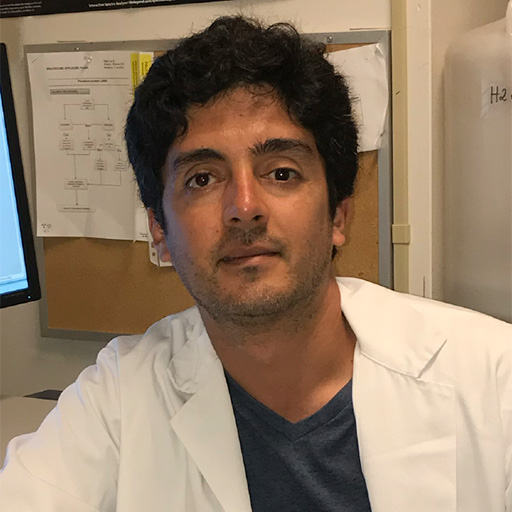In Vitro and In Vivo Studies of CD5L/AIM as a Possible Key Role Player in Drusen Biogenesis

Principal Investigator
Francesco Giorgianni, PhD
University of Tennessee Health Science Center
Memphis, TN, USA
About the Research Project
Program
Award Type
Standard
Award Amount
$160,000
Active Dates
July 01, 2016 - June 30, 2019
Grant ID
M2016068
Acknowledgement
Co-Principal Investigator(s)
Sarka Beranova-Giorgianni, PhD, University of Tennessee Health Science Center
Goals
We have discovered that certain cells of the eye, termed retinal pigment epithelium (RPE), that are typically damaged in age-related macular degeneration (AMD), express a protein that is targeted by the immune system of patients who have AMD by means of auto-antibodies. This protein we discovered in the RPE is a CD5 molecule-like protein/ apoptosis inhibitor of macrophage (CD5L/AIM). CD5L/AIM is a secreted scavenger receptor protein, and we have evidence suggesting that CD5L/AIM is very important in helping the RPE clear damaged lipoproteins (called oxidized low-density lipoproteins, or oxLDL) that accumulate under the RPE to form drusen deposits. The presence of drusen often is the first and most typical evidence that an eye has developed AMD.
Thus, we will culture RPE cells in vitro to prove that CD5L/AIM is a key molecule in clearing oxLDL and that, when blocked by an antibody as happens with auto-antibodies in patients who have AMD, the RPE cells will no longer be able to clear oxLDL. Lastly, to understand how the presence of auto-antibodies in the bloodstream of patients with AMD relates to disease in affected patients, we will study serum samples from AMD patients and correlate the levels of anti-CD5L/AIM auto-antibodies with how many drusen they have at the back of their eyes, as well as with certain genetic factors that are known to increase the risk of developing AMD. This will allow us to test the hypotheses that the more auto-antibodies one has against CD5L/AIM, the more drusen we are likely to find at the back of the eye, which would suggest that certain auto-antibodies facilitate formation of drusen in patients who have AMD.
Summary
The main objective of our research project is to reveal the cellular and molecular mechanisms involved in age-related macular degeneration (AMD) by studying two key pathological events that characterize AMD: the accumulation of drusen deposits and the death of retinal pigment epithelium cells (RPE). We expect that our work will provide new knowledge about the molecular pathways that underlie the formation of drusen in AMD; characterize a novel disease biomarker; and identify new therapeutic targets and strategies for AMD treatment.
We have established that patients with AMD present increased levels of auto-antibodies against a secreted scavenger receptor protein called CD5L/AIM (CD5 molecule-like protein/ apoptosis inhibitor of macrophage), which we discovered to be highly expressed in RPE cells. To date, the biological function of CD5L/AIM in the RPE is unknown. However, new evidence from our laboratory suggests that CD5L/AIM plays an important role in helping the RPE cells remove harmful accumulations of oxidized lipoproteins (oxLDL). RPE cells are typically damaged in AMD, and oxLDL builds up under the RPE cells to create drusen deposits that can induce an inflammatory response, leading to cellular death and retinal tissue damage.
Our first aim is to prove that CD5L/AIM is a key molecule in clearing oxLDL and that, when blocked by an antibody, analogous to what we believe happens with auto-antibodies in AMD patients, the RPE are no longer able to clear oxLDL, thus leading to drusen buildup. We are investigating how the function of CD5L/AIM in the context of oxLDL-induced damage influences the regulation of genes involved in metabolism/removal of oxidized proteins and lipids. These studies will help elucidate the exact molecular pathways that are involved in these mechanisms.
In the second aim, in order to understand how the presence of auto-antibodies in the bloodstream of patients with AMD relates to specific disease stages, we are analyzing serum samples from AMD patients and correlating the levels of anti-CD5L/AIM auto-antibodies with presence of drusen and with specific genetic markers known to increase the risk of developing AMD. This work tests the hypothesis that an increase in the levels of auto-antibodies against CD5L/AIM correlates with drusen levels, which would suggest that auto-antibodies against CD5L/AIM facilitate formation of drusen in patients with AMD.
Elucidation of the role of CD5L/AIM in drusen biogenesis and AMD pathogenesis will open new avenues for the design of therapies to modulate the removal and degradation of cytotoxic and pro-inflammatory oxLDL. In addition, our research will support the development of a new biomarker for early detection of AMD. These outcomes will make a significant contribution to the development of new treatments and cures that will improve quality of life for the millions of people impacted by this debilitating disease.
Grants
Related Grants
Macular Degeneration Research
Exosomes and Autophagy: Suspicious Partners in Drusen Biogenesis and AMD
Active Dates
July 01, 2024 - June 30, 2027

Principal Investigator
Miguel Flores Bellver, PhD
Exosomes and Autophagy: Suspicious Partners in Drusen Biogenesis and AMD
Active Dates
July 01, 2024 - June 30, 2027

Principal Investigator
Miguel Flores Bellver, PhD
Macular Degeneration Research
The Novel Role of an Intracellular Nuclear Receptor in AMD Pathogenesis
Active Dates
July 01, 2024 - June 30, 2026

Principal Investigator
Neetu Kushwah, PhD
The Novel Role of an Intracellular Nuclear Receptor in AMD Pathogenesis
Active Dates
July 01, 2024 - June 30, 2026

Principal Investigator
Neetu Kushwah, PhD
Macular Degeneration Research
Tracking How Rare Eye Immune Cells Respond to Damage in Age-Related Macular Degeneration
Active Dates
July 01, 2023 - June 30, 2025

Principal Investigator
Abdelilah Majdoubi, PhD
Tracking How Rare Eye Immune Cells Respond to Damage in Age-Related Macular Degeneration
Active Dates
July 01, 2023 - June 30, 2025

Principal Investigator
Abdelilah Majdoubi, PhD



